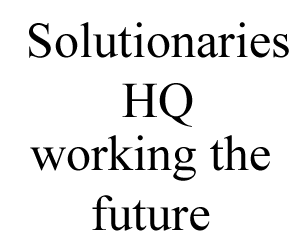 Circles Grow Solutionaries – kids with answers to things that matter!
Circles Grow Solutionaries – kids with answers to things that matter!
The ASPIRE principles for effective social and emotional learning
Dr Sue Roffey
Children learn ‘how to be’ and ‘how to live together’ (Delors, 1996) in their everyday experiences and interactions. The default position for some may support neither personal resilience nor healthy relationships. In the worst scenarios in schools this can lead to a learning environment where trust, respect and safety are in short supply, bullying thrives and the atmosphere is toxic. We need to actively teach and model the positive. Social and emotional learning is one of the seven pathways to school and student wellbeing (Noble et al, 2008) and evidence indicates that it also enhances student engagement, confidence and academic outcomes; pro-social behaviour, connectedness and resilience (Durlak et al, 2011). Really a no-brainer!
The UK Labour government brought in the SEAL (Social and Emotional Aspects of Learning) program initially for primary schools and later on for secondary. There was, however some criticism of this as ‘therapeutic learning’ in that it risked personal disclosure and was not always comfortable for teachers to deliver or students to engage with (Eccclestone & Hayes, 2008). There was some justification in this concern as SEAL was delivered with no clearly defined pedagogy. This also appears true of other SEAL programs. So often program content overrides process issues and then when it doesn’t work well, people think the content is no good and throw the baby out with the bathwater!
Circle Solutions has been designed to be a safe place for both students and for teachers and enable important issues to be discussed constructively within a solution-focused approach. The pedagogy is experiential (participants do things) interactive (together) discursive (talking about what they are doing) and reflective (thinking about how this promotes good relationships, good feelings and responsibility). The process a based in the ASPIRE principles. ASPIRE stands for agency, safety, positivity, inclusion, respect and equality. This is how it works.
Agency: One of the features of authentic wellbeing is self-determination. In Circle Solutions students are empowered and given a voice. They are encouraged to reflect on issues via the activities provided and make their own decisions about ways forward. Students themselves decide on how they want their class to be and the values (guidelines / rules) that will ensure that everyone feels good about being there. If you have some control over what happens to you it is harder to see yourself as a victim or develop a blame mentality – neither or which support strong reciprocal relationships. Teachers are in charge of Circles but do not control students. The aim is to develop self-control so the approach is Socratic rather than didactic – asking good questions, not giving answers.
Safety: Circles are NOT the place to sort out a fight in the playground or talk about what happened at the weekend. Students discuss issues, not incidents and do this via a wide range of creative, often game-based activities. It is the role of the facilitator to help students make connections between the games, the learning and real life. The third person is used to prevent participants giving too much personal information. For example, instead of having a sentence completion “My best friend…students instead discuss this in pairs to agree a completion for “A good friend is someone who… “ No-one has to speak unless they choose to do so and can simply pass – and do this for as long as they like. Students speak when they feel comfortable and have something to say. Almost all activities take place in pairs, small groups or the whole Circle so there is no individual competition. Working with others in safe, respectful groups reduces anxiety about making mistakes and increases a sense of trust and confidence. There is no naming, blaming or shaming.
Positivity: An obvious feature of a good relationship is enjoying being together. This is more likely to happen when people use strengths based language, solution-focused conversations, listen to each other and are considerate. Positive communication includes noticing and acknowledging someone’s qualities and contributions. This reinforces strengths, promotes a positive sense of self and deepens connection between people. It is likely to increase pro-social behaviour. Being able to laugh together is invaluable. It lifts spirits, creates a sense of belonging and boosts resilience. Circles are designed to be fun. A solution-focused approach means that instead of getting rid of problems the first question is ‘what do we want to happen’ and then seeing how far we have got and what we can build on. Positive relational values such as gratitude, kindness and trust are discussed and practiced.
Inclusion: It is our most vulnerable students who are most quickly marginalised Feeling you belong and you matter to the group is a protective factor against adversity. But there is exclusive belonging (me and my gang) and inclusive belonging (we welcome everyone). Inclusive belonging results in healthy environments whereas exclusive belonging leads to treating others as objects and is at the root of racism and intolerance (Roffey, 2013). In Circles participants are mixed up so they work with those outside their usual social group. Many activities are designed to promote a sense of connectedness, look at what is fair and not make judgments on limited information. As there is little demand for academic competence in Circles a wide ability range can be involved and teachers tell me that it works surprisingly well for students on the autistic spectrum. Circle Solutions is a universal intervention because perspectives – how students see each other – are as important as skills in changing student behaviour in sustainable ways.
Respect: When you ask people how they want to be treated many will say respect is all-important. Defining what this means is critical as the word can be linked to deference or admiration for possessions or power. Authentic respect is shown when someone really listens and does not pre-judge or jump to conclusions. Active listening is a complex skill but can be taught and if all students were given the opportunity to learn this in school it would immediately improve relationships at every level – as well as make for better conversations at parties! Two of the critical guidelines in Circles are listening when one person is speaking and not putting anyone down – either directly or behind their back. Respect also includes being able to admit you made a mistake or inadvertently hurt someone and showing you are genuinely sorry. When you treat people with courtesy they are more likely to reciprocate – and even if they don’t, you know you have behaved with personal integrity in line with your own values. This is the root of self-respect.
Equality: In the last few decades we have seen an increase in narcissism, individuals who are only concerned about what it best for them. It is hard for people whose mindset is all about ‘me’ to have a healthy relationship with someone else. Freedom to do what you like needs to be matched by responsibility to others and awareness of their rights. In organisations, including schools, often the loudest voices dominate and others are intimidated or lack confidence to speak up. A Circle puts everyone on the same level, promotes an equal voice and activities are structured to give each participant an opportunity to contribute, not leaving this to chance. In Circles the facilitator is on the same level as the students, engages in the same activities and models the behaviour expected. No-one is able to have more than their fair share of attention, power or control. Every voice counts. Wellbeing is highest is countries where there is least gap between the haves and the have-nots (Wilkinson & Pickett 2010). Equality matters at every level.
Teachers in both primary and secondary schools consistently say that Circle Solutions provide an effective pedagogy for social and emotional learning, changes the culture of the classroom and develops empathy, understanding and confidence.
This is supported by the research. (Dobia et al, 2013, McCarthy & Roffey, 2013)
To see for yourself watch this You Tube clip https://www.youtube.com/watch?v=jk_HTBu6bVg
For more information and resources read the book! (Roffey, 2014), see www.circlesolutionsnetwork.com or contact sue@sueroffey.com
References:
Delors, J. (1996). Learning: The Treasure Within. Paris: International Commission on Education for the Twenty First Century, UNESCO.
Dobia,B. Bodkin-Andrews, G, Parada, R. O’Rourke, V. Gilbert, S. Daley, A. & Roffey.S. (2013) Aboriginal Girls Circle: Enhancing connectedness and promoting resilience for Aboriginal Girls. Final Report Western Sydney University
Durlak, J.A., Dymnicki, A.B., Taylor, R.D., Schellinger, K.B., Weissberg, R.P. (2011). The impact of enhancing students’ social and emotional learning: A meta-analysis of school based universal interventions. Child Development, 82(1), 405-432.
Ecclestone, K., & Hayes, D. (2008). The Dangerous Rise of Therapeutic Education. London: Routledge.
McCarthy, F., Roffey, S. (2013). Circle Solutions: a philosophy and pedagogy for learning positive relationships. What promotes and inhibits sustainable outcomes? The International Journal of Emotional Education, 5(1), 36-55.
Noble, T., McGrath, H., Roffey, S. & Rowling, L, (2008) Scoping Study into Approaches to Student Wellbeing. Department of Education, Employment and Workplace Relations
Roffey, S. (2013) Inclusive and exclusive belonging: the impact on individual and community wellbeing Educational and Child Psychology 30(1) 38-49
Roffey. S. (2014). Circle Solutions for Student Wellbeing. London: Sage Publications.
Wilkinson, R. & Pickett, K. (2010) The Spirit Level: Why equality is better for everyone. London Penguin Books


